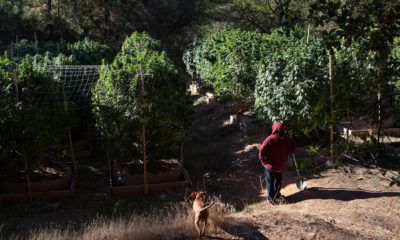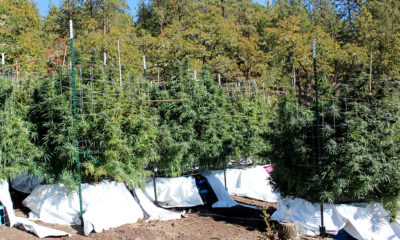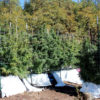
Cultivation
Weed in Wine Country
California cultivators in Santa Rosa County face delays in permits.
On the way north from San Francisco to the Emerald Triangle you must pass through some of the state’s most storied agricultural lands in Wine Country, including Sonoma County where the cannabis industry now faces unique challenges.
It was initially a relatively smooth transition for many of the county’s medical operators to the recreational market and much of that was thanks to a former department director who didn’t hate the industry. But new regulations and processes came for those who wanted to open up shop on in the adult-use marketplace. And then finally, in November 2019, the board of supervisors decision on minimum parcel size devastated the county’s oldest operators. That decision means you need to have 10 acres of land to grow an acre of pot. In addition, it means that the process to open up shop in the county’s unincorporated areas can take years.
This is all in contrast to the municipality of Santa Rosa, which has its ducks in a row and is now home to some giant pot companies as a result. The largest city south of the Emerald Triangle provides a ton of manufacturing infrastructure to farmers who come down from up north to rely on the city’s labor pool. Not to mention it’s the home of the Emerald Cup.
Many locals have been publicly venting about the permitting delays for months. After speaking with local operators and folks hoping to join their ranks, we reached out to the country to get their take on the cannabis permitting process. While they weren’t able to line up in an interview for a couple of weeks, a representative for the Board of Supervisors, McCall Miller, offered to answer some questions via email. The statements, she said, should be attributed to the county as a whole.
The first question centered around the challenges the County of Santa Rosa all have faced in licensing and how that might be unique to wine country since it has such a famed and embedded agriculture scene.
“With a deeply ingrained agricultural heritage here in Sonoma County, our traditional agricultural practitioners have been very wary of the adoption of cannabis as a potential crop for diversifying their operations primarily due to the federal definition of psychoactive cannabis as a Schedule I Controlled substance with its THC content,” the County of Sonoma told Cannabis Now in an email. “Some traditional agricultural practitioners have entertained leases of small blocks of their land to cannabis producers, but this is usually less than a couple of acres.
“Sonoma County has a maximum canopy per parcel of one acre. There have also been fears of cannabis crop compatibility with wine grapes due to the perceived potential of terpene transfer from cannabis to wine grape crops and fears that could taint the quality of the vintage.
“Additionally, since many traditional farmers in wine country come from a generation that demonized cannabis, it is difficult to get over those cultural aversions to the crop itself and the normalization of this plant as a legitimate opportunity in farming. That will take time and the adoption of cannabis as a diversification measure in farming will not happen overnight. Traditional farmers need to see economic research and market trends that demonstrate a reliable return on investment and express a relatively low or non-burdensome barrier to entry into the legitimate and legalized market.”
Part of the commentary we heard from stakeholders in the cannabis industry was around the way the county divides resources between the enforcement and permitting processes. With the argument being that the more simplified the permitting process, the more people will come under its umbrella, resulting in fewer resources needed for enforcement.
We asked the county how they break down resources around staffing for enforcement and licensing.
“Sonoma County has a very proactive code enforcement division within our planning department that is focused on the non-permitted black market cannabis industry and has been very active over the past few years working to bring those operations out of the shadows and into compliance,” the county replied. “For those that do not wish to enter the permitted environment, our code enforcement division has worked diligently to shut them down and to protect those that are seeking permits and licenses in the regulated market.
“If it is going to be safe it has to be regulated and consumers need reassurance that their local government is working to advocate for them. We have three staff working in permitting through our ministerial permitting program within our agriculture department and more than five staff members in the planning and permitting department working in policy development and permitting. Our code enforcement division is comprised of five staff that work cooperatively and collaboratively with permitting and agriculture department staff to permit and regulate.”
Finally, we asked the county what it would say to stakeholders who don’t understand where the bottleneck is in the licensing process since on the state level Chief Lori Ajax at the Bureau of Cannabis Control has said she has made getting licenses into people’s hands her major priority for the year?
“The bottleneck is the burdensome and onerous permitting and licensing process itself,” he county of Santa Rosa replied. “We have to remind ourselves that the BCC is just one of the agencies licensing operators. The BCC licenses distributors, transporters, labs, manufacturers and other supply chain businesses that are post-harvest, post processing activities and business types. The CDFA Cal Cannabis Cultivation Licensing division licenses cultivation, processing, and nurseries. The licensing of cultivation can be a long process depending on the jurisdiction. In addition to the process a bottleneck occurs due to the substance of the statutes and regulations themselves. The regulations are very comprehensive, detailed and often new and unique for the agencies that implement them, which slows administration and increases regulatory burden and cost.”
Sonoma’s original permittee, Fiddler’s Greens, is being forced to move their operation this summer after the county bumped up the minimum plot size.
“We worked really close with the ag department. We jumped through all the hoops, did all the things,” Fiddler’s Greens CEO Shannon Hattan told Cannabis Now in a phone interview. “We were kind of a poster child, and now we’re in an interesting situation because we’re less than ten acres. At the final round of making updates to the ordinance the board of supervisors decided they were going to change it to a ten acre minimum parcel size.”
After doing everything ever put in front of them, Fiddler’s was told to reach out to the county to see about getting an exemption. They didn’t hear anything back.
“We’ve made the tough decision we’re not cultivating in Sonoma County this year,” Hattan said.
TELL US, have you experienced any issues in a regulated cannabis marketplace?























